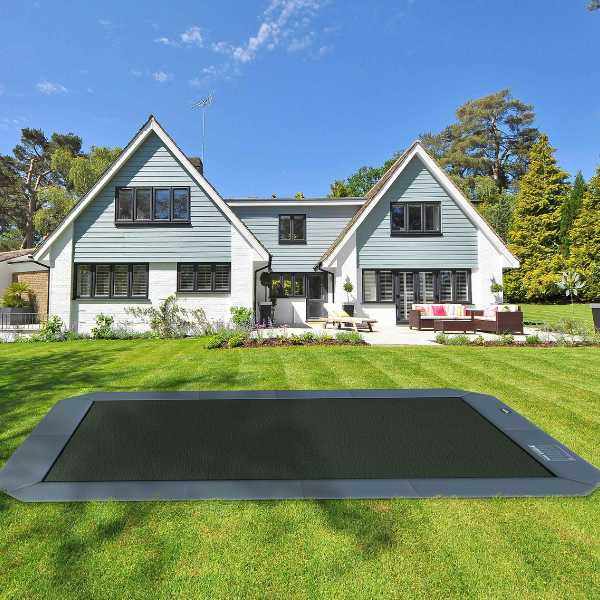Installing an in-ground trampoline can be an excellent way to enhance backyard fun while maintaining a sleek, low-profile landscape. However, many homeowners overlook one critical aspect of installation: drainage.
Failing to address in-ground trampoline drainage can lead to water build-up, structural issues, and even yard damage. Below, we explore how to prevent water build-up and offer practical solutions to ensure your trampoline remains safe and functional.
How to Prevent Water Build-Up in In-Ground Trampolines
Water build-up is one of the most common problems homeowners face after installing an in-ground trampoline. The hole dug for the trampoline becomes a basin, collecting rainwater and groundwater if not properly drained. Here's how to avoid this issue.
1. Install a Reliable Drainage System
A proper drainage system is essential. This can include:
- French Drains: Trenches filled with gravel and a perforated pipe that redirects water away from the trampoline pit.
- Sump Pumps: Ideal for areas with high water tables, sump pumps can automatically remove excess water.
- Drainage Pipes: Simple yet effective, pipes connected to a downhill grade can carry water away from the pit.
2. Use a Gravel Base
At the bottom of the trampoline's base lay down a thick layer of gravel. Gravel improves water percolation and prevents standing water from collecting around the trampoline's base. A gravel base combined with a drainage pipe or pump can significantly reduce water retention.
3. Ensure Proper Pit Lining
Use a perforated, breathable liner to line the trampoline pit. This can prevent soil from collapsing while allowing water to drain through the sides of the hole into the surrounding earth.
4. Choose the Right Location
Avoid placing your in-ground trampoline in a natural low spot in your yard. Instead, choose an area with a slight elevation or where water doesn't naturally pool. If your entire yard is relatively flat, grading may be necessary to redirect water away from the pit.
5. Keep the Trampoline Cover in Mind
Invest in a fitted trampoline cover to minimize water entering the pit during heavy rain or off-season. While it won't prevent all moisture build-up, it can reduce the amount of rainwater you need to drain.
Drainage for In-Ground Trampoline
Understanding how in-ground trampoline drainage affects your yard's overall water flow is crucial. When you dig a large hole, you interrupt the natural grading of your lawn. Without proper planning, this can have far-reaching effects on drainage throughout your property.
1. Alteration of Drainage Patterns
A trampoline pit can easily become the lowest point in your yard, especially in heavy rain. This attracts surface runoff and concentrates water in a single spot. If left unaddressed, this can cause flooding and soil erosion, not only around the trampoline’s base, but also in other parts of your yard.
2. Compacted Surrounding Soil
The machinery or manual labor involved in digging the trampoline hole can compact the surrounding soil. Compacted soil has poor permeability, meaning water won't soak in easily. This forces water to run off and may increase pooling around the trampoline or even affect nearby structures.
3. Negative Impact on Neighboring Properties
If water is not managed correctly, it could flow into your neighbor's yard, potentially creating disputes or damaging their landscape. It's essential to assess your entire yard's drainage layout before beginning any trampoline installation.
Common In-Ground Trampoline Drainage Mistakes to Avoid
Avoiding a few key mistakes during installation can make all the difference in the long-term functionality and maintenance of your drainage system.
1. No Drainage Plan at All
Too often, homeowners skip drainage planning entirely. Installing a trampoline without addressing where the water will go is a recipe for standing water, mold, rusted frame parts, and decreased lifespan.
2. Improper Grading Around the Trampoline
Water should flow away from the trampoline pit, not toward it. Ensure the surrounding area is graded correctly to direct water downhill and not toward the hole.
3. Overlooking the Water Table
In high-water-table areas, even the best drainage systems may struggle. Always check the depth of the water table in your region and be prepared to install more advanced solutions, such as sump pumps, if necessary.
4. Using Impermeable Liners
Some installers use plastic or rubber liners that retain water instead of allowing it to drain. Always opt for permeable materials that allow water to pass through and escape naturally into the surrounding soil.
5. Failing to Maintain the Drainage System
Even the best-designed drainage system requires occasional upkeep. Leaves, mud, and debris can clog pipes and gravel beds. Inspect the system regularly, especially after heavy rainfall, to ensure it's still working efficiently.
In-Ground Trampoline Drainage
Proper in-ground trampoline drainage isn't just a technicality; it's a necessity. From protecting the trampoline frame to preserving the integrity of your yard, drainage plays a key role in how well your installation performs over time.
By taking steps such as installing effective drainage systems, using permeable materials, and grading the landscape correctly, you can prevent water build-up and avoid long-term damage. When done right, an in-ground trampoline can provide years of safe, enjoyable use without turning your yard into a swamp.
Don't underestimate the importance of in-ground trampoline drainage. Plan well, install smart, and enjoy peace of mind every time someone takes a bounce.

